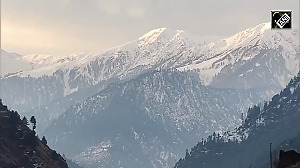 Sustained campaign forces NPCIL to issue statement on Kakrapar fuel leak.
Sustained campaign forces NPCIL to issue statement on Kakrapar fuel leak.
But there is still not clarity on what went wrong.
Rashme Sehgal reports.
Dr M V Ramana, a physicist with the Nuclear Future Laboratory on Science and Global Security at Princeton University, believes there is nothing "surprising" about the heavy water fuel leak at the Kakrapar nuclear plant in Gujarat.
Rather his assessment of the heavy water leak has only served to confirm the worst fears of the people living in and around Surat.
"Such leaks have been regular events at heavy water reactors in India," Dr Ramana said in an e-mail interview. "There could be a number of reasons for the leaks and I don't think we know the cause this time. I think the reason it is taking the station personnel so long to fix the problem is that radiation levels in the area must be quite high."
"The heavy water in the coolant circuit absorbs neutrons and becomes tritiated. Since the weather has become hot with temperatures in the upper thirties, the leaked heavy water will evaporate and any worker going into that chamber will have to breathe in the tririated water vapour, receiving a radiation dose."
"The exposure rate is probably quite high and that's one likely reason for how long it is taking NPCIL to repair it," he said.
Dr Ramana believes the apprehensions of the public living around the reactor are genuine. "However, my concerns is more for the workers in the plant," he said.
Regarding the issue of secrecy regarding this leak by both the Department of Atomic Energy and the Atomic Energy Regulatory Board, Dr Ramana maintained, "I think there could be two reasons (for this secrecy). One is that secrecy is probably a response to the concerns of people living around nuclear plants who are legitimately concerned about the possibility of a severe accident as well as continuous exposure to low-level radioactive releases."
"The second is that like all bureaucracies the DAE and the AERB do have a natural preference for secrecy. What sets apart the nuclear institutions from other bureaucracies is their ability to invoke themes like 'national security' and 'proprietary technology' to prevent questioning of their mode of operations," he said.
In response to repeated accusations of secrecy, the Nuclear Power Corporation of India Ltd finally used a statement on March 22 declaring that the Kakarapar Atomic Power Unit 1 was forced to shut down on March 11 following a leak in the primary heat transport system.
Giving a break up of what happened, NPCIL stated, 'The various safety systems came into play and the core cooling system got actuated as per design. The reactor cooling was continuously monitored thereafter by systems provided in the design.'
On the issue of increased radioactivity, NPCIL restricted itself to stating, 'The various environmental matrix in and around the plant were monitored for radioactivity by the Environmental Survey Laboratory of the Bhabha Atomic Research Centre to see if there was any increase in the radioactivity levels in the plant premises or in the public domain since the occurrence of the incident, but this was not the case.'
The source of the leak was identified to be from a coolant channel in the reactor building. Giving details of the reactor, NPCIL explained, 'The 220 MWe Pressurised Heavy Water Reactor core comprises of 306 coolant channels made of zinconium-niobium alloy, each of which house 12 fuel bundles. The coolant flows through these channels transferring the heat from the fuel to the steam generator to produce steam for driving the turbine to produce electricity.'
NPCIL further claimed that it used sophisticated remotely handled tools to remove the fuel bundles from the identified channels. 'The bundles have since been inspected and found to be intact without any damage. The affected channels have since been isolated and the leak arrested. No workers were involved in this operation. The radiological conditions remain normal and cooling is being maintained in all the channels.'
NPCIL admitted that the unit had been shut down and could be restarted only after the cause of the failure was investigated.
Meanwhile, Greenpeace has mounted a campaign to elicit more information from DAE, AERB and NPCIL. Hozefa Merchant, a Greenpeace campaigner on nuclear issues, pointed out, "When the Fukushima accident occurred, the Japanese authorities provided the world with real time data on a 24x7 basis. This has not happened in India where no specific information has been provided adding to the speculation and stress of those residing close to the plant."
The NPCIL statement does not mention the exact location of the leak. Is it the pressure tubes, the feeder tubes, or the calandria tubes, or something else, he asks.
'As you are aware, there are 18 PHWRs in India from which 8 are over the age of 20 years. These 8 reactors are of CANDU design. The reactor in question, Kakrapar Unit-1 reactor was rated as the best performing CANDU reactor across the world by the CANDU Owners Group in 2003. This alone would make the information relevant not just for India, but also for all other countries that operate similar reactors. Is the leak linked to the age of the reactor?' Merchant asked AERB in an open letter.
Dr Ramana, however, attributes other causes for the leak. "According to authorities, the specific component that leaked was refurbished in 2011. So it is probably not the age that is responsible." The exact details will be known following the availability of more information.
Merchant and other nuclear activists has asked DAE to observe the standard precautionary measure and shut down the remaining seven heavy water reactors in the country until the investigations are completed. 'All these reactors also need to be examined,' Merchant maintained, 'and this is a standard procedure across nuclear plants.'











 © 2025
© 2025